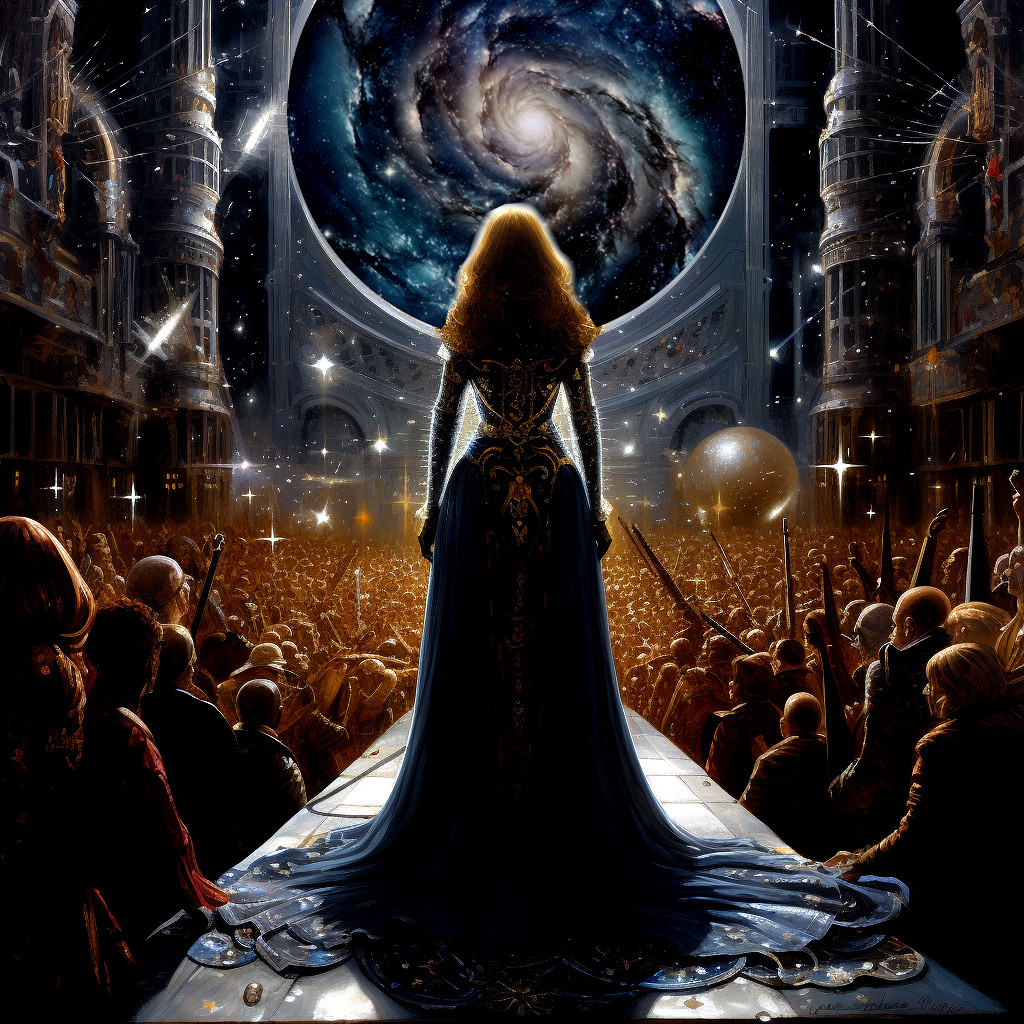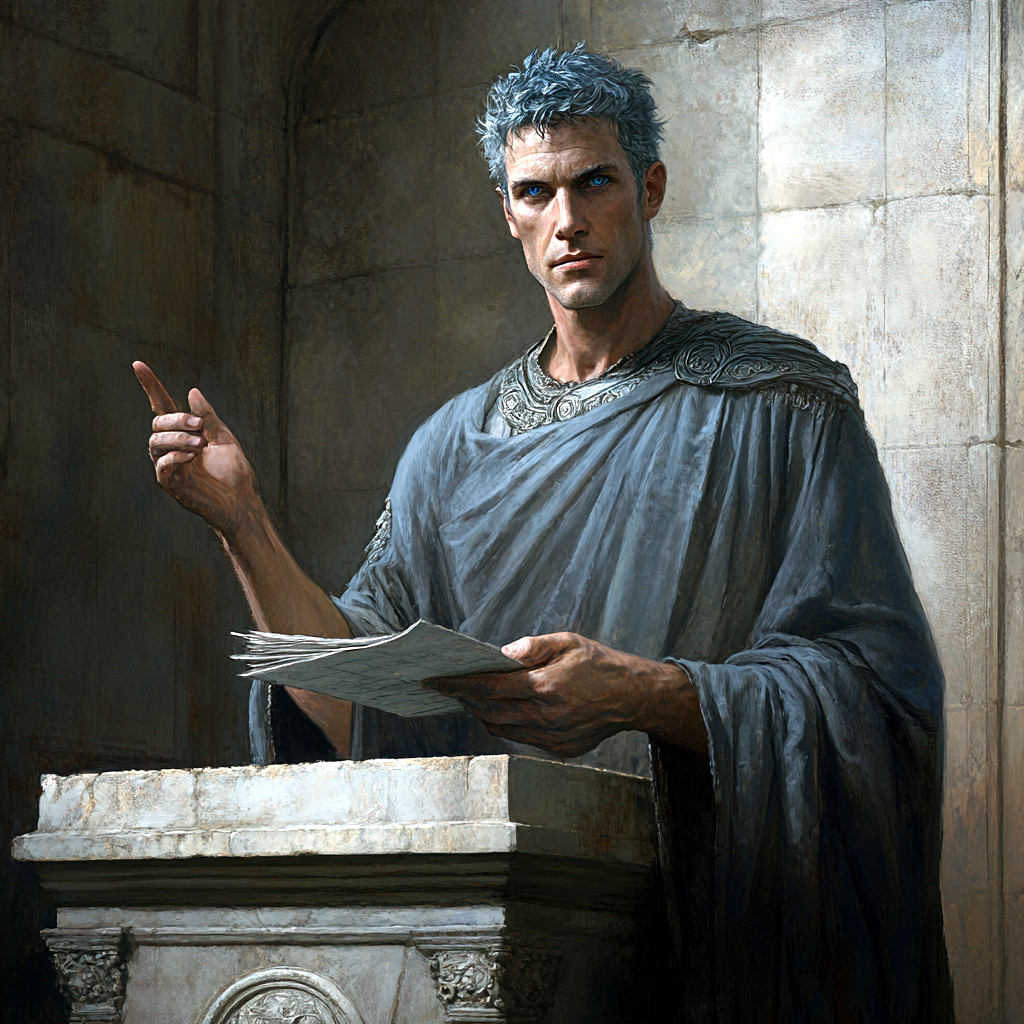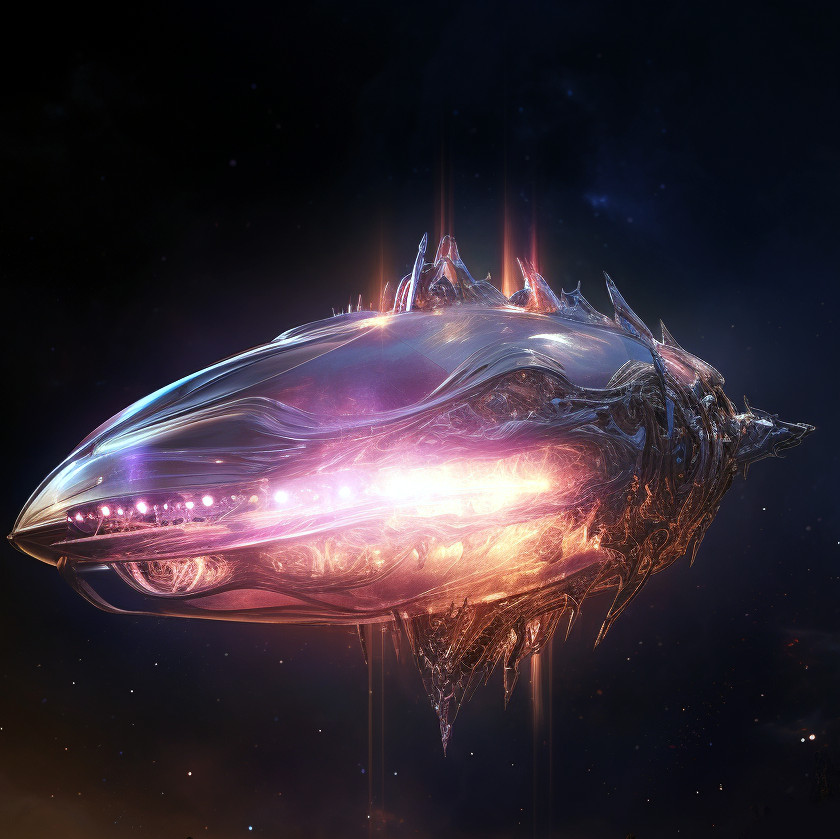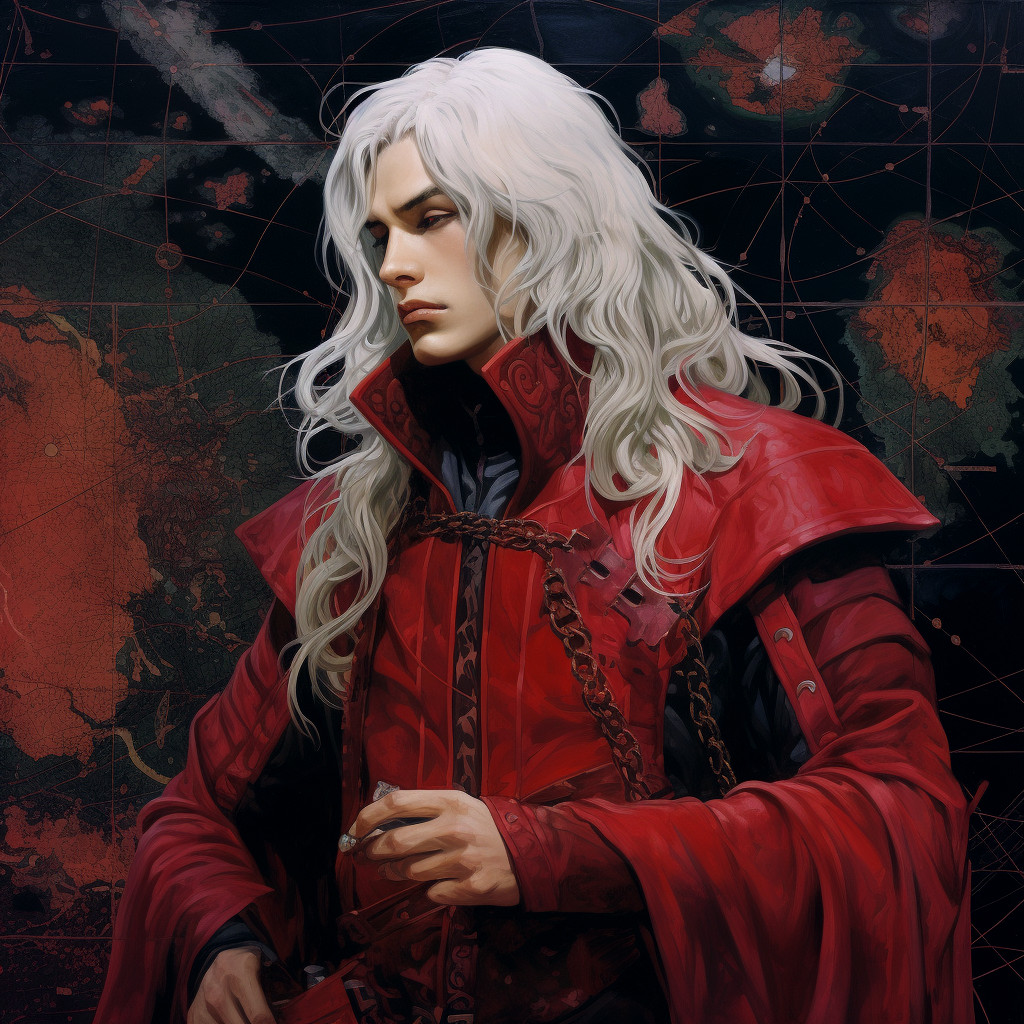Conflicts that shaped Mindsea Empire | |
The Fall of Ulona | |
Attequol destroyed Ulonan civilization. |
As he gathered planets for the Empire's foundation, Attequol discovered the vast, lush world of Ulona, and hoped to include it in his plans. The Ulonans had their own plans, and fiercely resisted. They were no match for Attequol's patternistic weapons, and the war ended with the utter destruction of Ulona. |
War of the Soul-Gems | |
Clashing soul-gems threatened to split reality in two. |
Raging against an empire dominated by privileged aristocrats who basked in the glow of the soul-gem Attequol had bequeathed them, Quokisa forged her soul-gem for the people. In her reality, there would be no aristocrats. Everyone would gather as much of the universe's bounty as their wits and their determination afforded them. The priesthood she had banished upon ascending the throne never ceased their efforts to make their reality ascendant, and employed psychological warfare and chemical influencers to win the Common Mind to their vision. Ultimately their schemes proved successful, and Quokisa's soul-gem was destroyed. Timeframe: 6,442-8,404 |
The Bioid War | |
Multiple versions of living beings manifest on the quantum level. |
After overthrowing Mindsea-Empress Tseorue, Emperor Smoatsus set about reshaping the Empire with his vision, which was for technology to duplicate and exceed all of the abilities granted by mindpowers. One of his ideas was that ordinary people could avoid crystallization, just as did mindseas, if they had bioid copies of themselves replace their natural bodies. His successor, Empress Kalfia, made the bioid project first on her agenda, promising a bioid copy for every citizen. There were objections to her plan, spearheaded by the former empress, who claimed her mindpowers told her that bioids, just as crystalloids, were not alive, despite their perfect macroscopic mimicry of an original human as well as their own claims that they were living, feeling beings. Since these claims were untestable, Kalfia accused Tseorue of lying. Tseorue's followers devised a test showing that, whereas living creatures had fluctuating subatomic structures caused by alternate versions bubbling through on quantum refresh, bioids and crystalloids did not. Kalfia accused her opposition of falsifying their results, and led her bioid army to crush them. The bioids were defeated by Tseorue's Deep-level weapons, against which they were defenseless. Since the time of Tseorue's restoration, no Proposal to grant rights to bioids has found support in either branch of imperial government. Timeframe: 15,449-15,758 |
Breaking the Ring | |
Skort's Ring managed citizens' lives. |
Toward the end of the Evolved Plutocracy, when galactic corporations ruled the Empire, an entrepreneur named Skort rose to prominence with his inventions. His "Ring of Truth" collected memories from each moment of a citizen's life and wove them into stories full of verve and significance. For a few more credits, it would suggest activities to enhance the user's life. Those with top-tier subscriptions had their niches, mating flights, and child-rearing decisions made by the Ring. They never faced any uncertainty, for the Ring charted their optimal life courses. In time, seventy percent of the galaxy subscribed at some level. Skort's detractors cited statistics linking heavier Ring use to earlier crystallization and called for the Ring to be banned. "You can't forbid citizens from hiring time managers," Skort laughed. When Empress Ashia ascended the throne and began to strip the corporations' power, she took up the battle. "Citizens are free to hire time managers," she said, "but they must be told the truth about what they are buying. The Ring is not programmed to enhance their lives, it is programmed to siphon their credits. It has no algorithms for finding optimal life courses. It gives citizens easy answers so they will continue to pay. It tells them their lives are meaningful, but it lies. A life of self-absorption and constant self-applause does not benefit anyone other than Skort and his cronies, least of all the fool wallowing in it." Laws were enacted to trigger warnings after every decision suggested by the Ring. Subscriptions plummeted, and Skort left to peddle his wares to non-imperial worlds. Holistic product evaluation codes have remained in effect throughout the Empire. Timeframe: 17,394-20,973 |
Bid for Immortality | |
Ashia could have ruled forever. |
When Empress Ashia died after the longest continuous reign in imperial history, her longtime husband, Plithin, and their son Orto launched a movement to have her copy floated and enthroned. They argued that some people, like Ashia, were so irreplaceably important that they should be granted immortality—their genes preserved so that they could be copied for perpetuity. Ashia and Plithin's mindsea son, Zipo, opposed the movement. He pointed out that imperial science could not copy the Deep-level portion of his mother's personality, and her connection to the Deep had not been strong enough for the Deep-mind to charge a copy. Thus, the copy would not be her; she would be a twin sister. In addition, since Ashia had been crystallized for two hundred years and Plithin and Orto had been ruling the Empire in her name, their motives were suspect. The brothers raised their armies, Orto backing their mother's copy for the throne, and Zipo supporting a man named Krintue. The armies clashed. Zipo, a military genius, crushed Orto's forces, and Krintue ascended the throne. Krintue reigned for only a couple of centuries before he was overthrown by an upstart named Rathax. But ever since the start of his reign it has been imperial law that no person over the age of ten thousand may be copied, and that citizens' gene specs must be deleted from the imperial datasphere upon their death. Timeframe: 30,256 |
Judgment against Rathax | |
Rathax celebrated victory in the instant before death. |
Rathax came to the throne with the intention of remaking the Empire in his own image. As a blue son of Ul, he hated the works of Attequol, especially the soul-gem-powered energy temples that dominated every planet. The priesthood that once had guarded the temples had long since vanished, but the temples had powerful fusion fields that made them nearly impregnable. The soul-gem channeled the Empire's communications along one timeline, but it was a timeline chosen by Attequol, and Rathax wanted it changed. Without a soul-gem, the Empire would diverge along countless timelines, but that wasn't a problem for Rathax. He had been Emperor on the united timeline, and would remain emperor on all of its branches. Just think of the resources he could collect by revisiting a planet on multiple timelines! It was a beautiful dream. He commenced to make his dream reality by tearing down the temples on every planet, freeing them from Attequol's direction. It was the labor of millennia, but at last he accomplished what he had set out to do. Only one temple remained—the greatest of them all, the Temple of Lal. As long as it stood, Attequol's soul-gem still shone. The temple crackled with hostile power, but Rathax exerted his mindpowers and entered its sanctuary. A mighty upheaval shook the capital. Rathax had succeeded, the temple had fallen, and the soul-gem was shattered. But Rathax was gone; no trace of his body remained. People gathered in wonder around a massive wall—all that remained of the temple. The story began that the top of the wall must have crushed Rathax when it fell. He had been judged and condemned by the spirit of Attequol. Afterwards, the wall was known as the Judgment Wall, and every emperor after Rathax stood before it to be judged. When they were not crushed, it was manifest that they had been judged worthy of leading the Empire. Timeframe: 35,633 |
Walpurgians Versus Revelationists | |
Walpurgians and Revelationists are a metaphor for the eternal war between entropy and energy. |
When Zipo ended the Unfused Plutocracy and militarized the Empire, a galactic safety ranger named Blijue Beli founded an opposition party who called themselves Walpurgians. Blijue Beli was guided, he claimed, by the an exhibit Attequol had created in the Imperial Museum. The exhibit told about human history going back to ancient times on Earth. Humanity had ever been divided into two warring factions—the Walpurgians and the Revelationists. The Walpurgians named themselves after Walpurga, the first woman to record history in writing. They were preservers. Revelationists were always getting thunderstruck by some novel idea they considered holy, which made them want to sweep away everything that had come before. They were destroyers. Zipo was a Revelationist, and his violent acts would erode the Empire. He must be stopped. Zipo just laughed at his detractors, but he had apologists who defended his policies. Patternists explained that Attequol's exhibit was not meant to be taken as history. It was an allegory about the nature of reality. All existence was pattern, and the minimum requirements of pattern were bits that could be differentiated, like the black and white squares of a chessboard. The Walpurgians and Revelationists personified the squares of the chessboard. The Walpurgians were the black squares, quiet and conservative. The white squares were Revelationists, brimming with explosive energies. It should be clear to anyone that both were necessary for existence. Blijue Beli argued that galactic civilization would prosper with less destruction, and when Zipo continued to wage wars against imperial worlds that wished to follow diverging timelines and against foreign empires, the majority of citizens lost confidence in him. Challenges for the throne came every year, and although Zipo was the master of Deep-level duels on horseback, he was eventually defeated, and the throne passed to a grandson of Blijue Beli. The notion of an eternal war between Walpurgians and Revelationists has resurfaced from time to time. During the Contested Era, Quintillion and Thermeon played the roles of preserver and destroyer more perfectly than any warring mindseas before or since. Timeframe: 38,367-38,633 |
The Green Wave | |
Wastoe was inspired by the ocean's ecosystem. |
While Yutubis, a man from an unknown family, sat on the galactic throne, a woman named Wastoe launched a movement calling for changes in the human genome. She had worked as an aquasphere ranger, and she had noted how ocean ecosystems were powered by the sunlight penetrating the water's surface. If humans powered themselves in the same way, dispensing with complex systems of food production, a wave of prosperity would sweep the galaxy. Photosynthesizing endosymbionts were well-known. If all citizens were infused with them, they would commence converting sunlight directly into food. Not only would their lives become more efficient and prosperous, the moral dilemma surrounding the consumption of animal and plant products would also be solved. On every planet, multitudes answered Wastoe's call in what was hailed as a "Green Wave." Planetary governments mandated green citizens. Emperor Yutubis proposed a galaxy-wide conversion. Head of the Circle Krorl hesitated. Zipo had been serving as admiral of the imperial fleets since his overthrow. He loudly derided the Green Wave. "It will dissolve on the rocks of reality," he predicted. "If humans turn themselves into plants, they will be ripe for harvesting by some other species. Hunting, reaping, and battle are necessary components of the human makeup. Does the Common Mind want an emperor or a wimperor?" Citizens backed Zipo's challenge to the throne, and he defeated Yutubis and returned to power. The Greenist movement persisted, but it never again verged on becoming imperial law. Timeframe: 40,687-41,161 |
The Egg Crisis | |
Imperial citizens experimented with oviparity. |
During the reign of Empress Svalmips, a bioengineer named Aex, granddaughter of Wastoe, began to promote her enhancements to the human genome. Sheddable insect wings for mating flights and oviparity became all the rage. When Svalmips moved to forbid permanent changes to the human form, Aex found an ambitious youngster named Iulf who promised to be more amenable to such reforms if she sat on the throne. As leader of the New Humanity Party, Iulf challenged Svalmips to a mind-duel for the throne. She had no mindpowers, but Aex, who did, fought for her and defeated Svalmips. An era of fantastic changes ensued. Humanity branched into a number of different lineages—some adapted for flight, others for underwater life, some huge, or with huge heads, others small as ants. The varieties were endless. Soon every human type formed its own party, agitating for changes to suit its way of life. Ancestral-type citizens felt threatened and turned to Svalmips to champion their cause. She challenged Iulf for the throne and, forewarned this time about Aex, defeated them both to effect her comeback. Altered humans were denied reproductive rights, and all future alterations to the human genome forbidden. Cosmetic enhancements were still permitted, as long as the changes would not be passed to offspring. Interspecies mating was permitted. Citizens could still grow temporary wings and lay eggs if they wished, but the fad had passed. Laws against altered humans enacted after the restoration of Svalmips were never rescinded. Timeframe: 50,868-51,883 |
War Between Men and Women | |
Aex advocated the cloacal kiss. |
In 52,161, a man who went by his second name, Ulte, overthrew Svalmips to become emperor. He represented those who believed the troubles of the preceding millennia had been caused by female emperors. He noted that two sexes were no longer necessary for human reproduction. He himself had a male lover and had produced only male offspring. Why couldn't the galaxy follow his lead and abolish the unnecessary second sex? Ulte's Proposal was rejected by Head of the Circle Plaushank, who called the Emperor a limited individual. Ulte and the son who followed him continued to plead their case. A single-sex humanity would be free from misery and crime sparked by conflicts between men and women. Opposition parties put a woman from an unknown family on the throne in 53,171, but a resurgent "Males Only" movement led by Ulte's grandson Yestur was back in power in 53,372. Yestur was succeeded by his cousin Snasi. In 54,479, a woman named Kraeshal replaced Snasi, but not until her niece Jeivia took the throne did the "Females Only" movement find its most dynamic advocate. Jeivia had female lovers and produced female children. Was this not more natural than Ulte's way? She had her precedent in parthenogenesis. Since conflicts between men and women resulted from male aggression, wouldn't elimination of males be the more just solution? As the galaxy split into warring camps, a voice of moderation came from Green Wave Supervisor Aex. "Let us remain men and women," she said. "But let us become more equal partners in the sexual act by altering our genitalia to resemble those of the birds. There will be no more penetrations—the love act will consist of a gentle cloacal kiss. Opportunity for violence is banished, but delight remains." When Svalmips regained the throne in 55,973, she and Plaushank settled the gender issue with a joint Proposal: "The human species has evolved with our sexuality over millions of years. Drastic changes may have unintended consequences, so until all possible ramifications have been thoroughly analyzed, there will be no changes. Individuals may alter their genitals if desired, but alterations may not be passed on. Nor may parents choose the gender of their children." Aex promised to investigate all consequences of human cloacae, but results remain pending. Timeframe: 52,161-55,973 |
The Ziponists | |
Ziponists assassinated Besi. |
When Empress Besi outlawed mind-duels and made the Empire a meritocracy, a great number of people felt that a cherished tradition was being set aside for no valid reason. What besides a mind-duel could determine the person most fit to rule a mindsea empire? The disaffected called themselves Ziponists after Zipo, the famed dueling emperor. The old method of challenges for the throne had been replaced by an examination for fitness, so they resorted to illegal violence, assassinating Besi officials and blowing up examination sites. In 65,529 a Ziponist succeeded in assassinating the Empress, and a former mind-dueling emperor, Trero, returned to the throne. But in a surprise move, Trero refused to restore the mind-dueling succession rules—perhaps he worried about his own ability to continue victorious in such contests. The Ziponists kept up their attacks until mind-duels were again made legal during the reign of Empress Steolfeen. By then violence had become a way of life for descendants of the original group. They continued to call themselves Ziponists and to commit acts of violence long after their purpose was removed. Timeframe: 64,910-76,558 |
The Za Leit Wars | |
Za Leit expected everyone, including her pets, to play by her rules. |
Za Leit started life as a gaming champion, and never stopped seeing life as a game that she was determined to win. Combining vast mindpowers with an ability to focus on and master any scientific field she found interesting, she restored the Empire's transaxial travel and communications systems and stamped out the last of the Ziponists who had constantly sabotaged those systems. Za Leit was uncompromising in her insistence that all citizens obey the rules of the galactic game that she, as empress, set forth. Business interests and aristocrats who had reaped unearned rewards during the previous era through bribery and extortion found their old tactics worthless in her realm. Offenses brought to her attention unleashed swift and severe punishment. Za Leit had the worst offenders brought before the throne in a public ceremony during which she executed them with her mindpowers, ramping up and prolonging their agony for the Common Mind's edification. Za Leit regarded weakness and cowardice in the same category as criminal behavior. For amusement, she would tweak probabilities to unleash firestorms or meteor barrages against "snivelers" and observe their struggles for survival from her lofty perspective as the galaxy's most powerful mindsea. Business interests combined with disgruntled scions of formerly influential families to bring her down. On three separate occasions her military leaders were convinced to turn on her and she was captured. But her captors' hopes that she would maintain her Deep-level systems from prison were disappointed. Neither threats nor promises could induce her to cooperate. She laughed at pain and belittled her interrogators from her dungeon. Without her guiding mind, intragalactic commerce broke down and planet-to-planet transmissions faded into the multiverse. Za Leit broke free twice to resume her games, though her foes gave her little respite. During her third captivity, a young mindsea named Zupa created a new Deep-level system for the galaxy, and Za Leit died forgotten in an impregnable prison. Timeframe: 78,655-86,227 |
The Blue-Eyed List | |
Ir lectured on the superiority of blue eyes. |
Ir Hakrif Haliak, chief of the Sages of Mosalno, disgusted by perceived outrages of Emperor Xublian, outrages like the vanishing cities of Riom—actually caused by Imperial Major Horl—decided that Xublian's genes must be at fault, specifically the genes that gave him black eyes. He invented a scheme to determine a person's worth according to their eye color. Blue and green were best—his longtime husband's eyes were green. Violet was also acceptable, being a shade of blue. Black and brown eyes meant danger, resulting from the admixture of subhuman Nander genes. Red and amber eyes meant a person had ties to the barbaric Code Empire. Hazel eyes were suspect as well—probably the result of both Nander and Code genes. Ir formed an advocacy group and presented his Proposal that only people with blue eyes or their equivalent be enrolled on the Galactic and Planetary Lists of a Thousand. This would lower the prestige of citizens not listed, and lead to fewer mating opportunities for them, and thus less proliferation of undesirable genes. Neither Emperor nor Bureau endorsed his Proposal. Blue-eyed Head of the Circle Raolin spoke his opposition, stating that none of the alleles giving imperial citizens their skin, hair, and eye colors had links to any negative quality. He was Expert of Genetic Algorithms, and this was his specialty. Ir continued to argue that Nander genes and Code genes were responsible for odd-colored eyes, though Raolin listed countless examples where no trace of such genes could be found in black- and red-eyed citizens. Disgruntled, Ir called on blue-eyed Horl to champion the cause with Emperor and Head. Horl demurred, pointing out that his black-eyed wife would kill him if he did. After Kronia crystallized, Ir once again called upon Horl. Tired of inventing excuses, Horl infused Nander genes into Ir and Bemer's incubator, producing a black-eyed daughter. Convinced at last that black eyes could appear spontaneously, Ir ceased his agitation. Timeframe: 95,316-98,397 |
The Ghost War | |
Fuerida pursued the ghost of Horl with her Deep-level sword. |
Early in the reign of Emperor Thermeon, a conspiracy by two of Horl's daughters to restore human slavery made Thermeon believe that Horl's ghost was attempting a return to power. He set out to exorcise the ghost and fell into the trap Ix and Xeera had set. After escaping and blasting the women's puppet emperor in a mind-duel, Thermeon reclaimed the throne and continued his anti-slavery reforms. Timeframe: 99,607-99,737 |
The Code War | |
Thermeon flew his pentascoper, Sola, in the war. |
Remnants of the Ulonan people who had fled their doomed homeworld during the war with Attequol had settled on some three hundred planets. There they established an independent empire with laws and traditions based on The Book of the Code written by their empresses under inspiration from the Goddess they worshiped. When contact with the Empire of the Common Mind was reestablished during the Decadent Epoch, people of the Code vowed to avenge the wrong that had been done them long ago. They launched fleets of Home-level ships against the hated enemy. Though entirely lacking in Deep-level technology, they felt certain their devotion to the Goddess and the decadence of the enemy would grant them victory. The slow Code ships arrived at their targets during the reign of Thermeon during the Contested Era, and several bloody battles ensued as Code attackers fought furiously to the last man, woman, and child. The war ended when Thermeon—some say by trickery—married the Code Empress. Timeframe: 99,758-100,107 |
The Great War | |
Maxuas made careful plans for the war. |
Maxuas, son of Emperor Thermeon and the Code Empress, was the hope of the future for both his parents' peoples. When he came of age, his father divided the galactic empire, giving half of the planets to his son to rule. Maxuas immediately implemented his secret plan to take over the entire galaxy, kill his father, and avenge his mother. A cautious, thoughtful man, Maxuas explored every angle as he made his preparations. When he was certain that his fleets and his weapons were superior to his father's, he commenced his attack, hoping for a quick victory. The war escalated quickly into horror as Maxuas had to call forth more and more of his genetic weapons to crush his father's resistance. The gruesome deaths experienced by victims of his genetic alterations finally broke down Thermeon's inhibition against striking out at a beloved son, and Maxuas's capital, the beautiful planet Wamatu, was devastated in the same manner as the people of the Code's ancestral world, Ulona. Timeframe: 102,240-102,253 |
The Lesser War | |
Torm's copy fell into trance in the ice palace of Niom. |
When disgruntled Emperor Quintillion fled his responsibilities, his major elevated his stepson Torm to the throne. The depredations of this angry young mindsea so alarmed the Common Mind that Quintillion had to be coaxed into making a comeback as emperor of the planets that had been Maxuas's during the Great War and allowing his people to fight Torm. Torm came up with a foolproof plan for victory: if there were two of him, he could hunt down his stepfather while remaining in Lal to direct his fleets. He shared his mindpowers with his copy, and sent him to Niom to confront Quintillion. The plan backfired when Torm and his copy became locked in mind-link arguing about which of them would rule the galaxy after their victory. They would not emerge from their trance for hundreds of years after the end of the war. Timeframe: 103,527-103,817 |
The Nander War | |
Quintillion reeled with guilt over the slain. |
After Quintillion's restoration at the end of the Lesser War, he decided that damage to the spacetime fabric caused by Deep-level ships could be avoided if ships were piloted by members of his father's ancient people, the Nanders. He also began to construct trans-gates to replace the nonfunctioning Decadent Epoch transways that had replaced the lost transaxial system of the Meritocracy. Nander pilots practiced their time-honored ritual of blood sacrifice, claiming a victim for each flight of a ship or trans-gate passage. The outraged Common Mind demanded that they be punished, but Quintillion refused. The conflict dragged on until the end of his reign. His successor's first act was to remove Nander pilots from ships transporting humans, and the killings ceased. Timeframe: 103,840-104,037 |
The Aiggle War | |
After the battle, Shell collected the spoils of war, including an aiggle egg. |
A Deep-level being known as Aiggle began preying on interstellar shipping in Sector Eight. Human fleets sent against it were destroyed, and many citizens feared that the Empire was doomed. Thermeon defeated the Aiggle with his Buzzfly Squadron. Timeframe: 104,822-104,825 |
War Between Levels | |
Archways on every planet would open the way to the Deep. |
The ultimate goal of the Age of Illumination was to guide humanity into a Deep-level life. When Thermeon attempted to achieve the "Crossing-Over," violence broke out between those who saw themselves destined to take this next step in evolution, and those who chose to continue living as humans. Mindseas themselves were split on the issue. In the wake of the terrible cataclysm set off by their battling, Palace and Bureau resolved to settle the Ziponist issue once and for all. Mind-duels would never again provide the measure of fitness for the galactic throne. Instead, a one-time third government branch, the Mindsea Academy, would be restored, its purpose to test the fitness and the humanity of candidates for government positions, including the imperial throne. Timeframe: 106,057-106,432 |



















